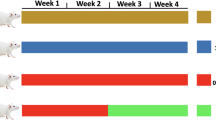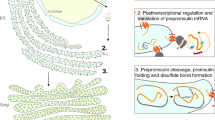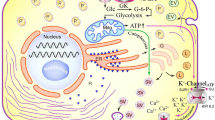Abstract
The objective was to investigate the mechanism of the protective effect of silibinin on amylin/Aβ1−42-induced INS-1 cell apoptosis, with special reference to the roles of glucagon-like peptide-1 receptor (GLP-1R) and protein kinase A (PKA). The effects of silibinin on apoptosis, insulin secretion, GLP-1R, and PKA expression in the INS-1 cells treated with amylin/Aβ1−42 were examined. INS-1 cells exposed to amylin showed increased TUNEL-positive ratio, reduced expression of GLP-1R and PKA. GLP-1R antagonists or PKA inhibitor enhanced the expression of apoptosis-associated proteins and TUNEL-positive ratio. Silibinin exerted antiapoptotic effect on and upregulation of GLP-1R and PKA. However, Aβ1−42-induced INS-1 cell apoptosis, GLP-1R, and PKA expressions were not changed. Our results indicate that down-regulation of GLP-1R and PKA contributes to INS-1 cell apoptosis induced with amylin. Silibinin protects INS-1 cells from amylin-induced apoptosis through activation of GLP-1R/PKA signaling. Silibinin’s inhibition of the toxic effects of Aβ1−42 is independent of GLP-1R/PKA pathway.





Similar content being viewed by others
References
Donath MY et al (2005) Mechanisms of beta-cell death in type 2 diabetes. Diabetes 54(Suppl 2):S108–S113
Sahyoun NR et al (2008) Dietary diabete glycemic index and glycemic load and the risk of type 2 diabetes in older adults. Am J Clin Nutr 87:126–131
Janikiewicz J, Hanzelka K, Kozinski K, Kolczynska K, Dobrzyn A (2015) Islet beta-cell failure in type 2 diabetes—within the network of toxic lipids. Biochem Biophys Res Commun 460:491–496. https://doi.org/10.1016/j.bbrc.2015.03.153
Haataja L, Gurlo T, Huang CJ, Butler PC (2008) Islet amyloid in type 2 diabetes, and the toxic oligomer hypothesis. Endocr Rev 29:303–316. https://doi.org/10.1210/er.2007-0037
Westermark P, Andersson A, Westermark GT (2011) Islet amyloid polypeptide, islet amyloid, and diabetes mellitus. Physiol Rev 91:795–826. https://doi.org/10.1152/physrev.00042.2009
Park YJ et al (2013) The glucagon-like peptide-1 receptor agonist exenatide restores impaired pro-islet amyloid polypeptide processing in cultured human islets: implications in type 2 diabetes and islet transplantation. Diabetologia 56:508–519. https://doi.org/10.1007/s00125-012-2802-z
Jurgens CA et al (2011) beta-cell loss and beta-cell apoptosis in human type 2 diabetes are related to islet amyloid deposition. Am J Pathol 178:2632–2640. https://doi.org/10.1016/j.ajpath.2011.02.036
Velander P, Wu L, Ray WK, Helm RF, Xu B (2016) Amylin amyloid inhibition by flavonoid baicalein: key roles of its vicinal dihydroxyl groups of the catechol moiety. Biochemistry 55:4255–4258. https://doi.org/10.1021/acs.biochem.6b00578
Ma L, Li X, Wang Y, Zheng W, Chen T (2014) Cu(II) inhibits hIAPP fibrillation and promotes hIAPP-induced beta cell apoptosis through induction of ROS-mediated mitochondrial dysfunction. J Inorg Biochem 140:143–152. https://doi.org/10.1016/j.jinorgbio.2014.07.002
Zhang XX, Pan YH, Huang YM, Zhao HL (2016) Neuroendocrine hormone amylin in diabetes. World J Diabetes 7:189–197. https://doi.org/10.4239/wjd.v7.i9.189
Verma N et al (2016) Intraneuronal amylin deposition, peroxidative membrane injury and increased IL-1beta synthesis in brains of Alzheimer’s disease patients with type-2 diabetes and in diabetic HIP rats. J Alzheimer Dis 53:259–272. https://doi.org/10.3233/JAD-160047
Mietlicki-Baase EG (2016) Amylin-mediated control of glycemia, energy balance, and cognition. Physiol Behav 162:130–140. https://doi.org/10.1016/j.physbeh.2016.02.034
Fu W, Patel A, Jhamandas JH (2013) Amylin receptor: a common pathophysiological target in Alzheimer’s disease and diabetes mellitus. Front Aging Neurosci 5:42. https://doi.org/10.3389/fnagi.2013.00042
Lutz TA, Meyer U (2015) Amylin at the interface between metabolic and neurodegenerative disorders. Front Neurosci 9:216. https://doi.org/10.3389/fnins.2015.00216
Akesson B, Panagiotidis G, Westermark P, Lundquist I (2003) Islet amyloid polypeptide inhibits glucagon release and exerts a dual action on insulin release from isolated islets. Regul Pept 111:55–60
Baggio LL, Drucker DJ (2007) Biology of incretins: GLP-1 and GIP. Gastroenterology 132:2131–2157. https://doi.org/10.1053/j.gastro.2007.03.054
Holst JJ (2007) The physiology of glucagon-like peptide 1. Physiol Rev 87:1409–1439. https://doi.org/10.1152/physrev.00034.2006
Salehi M, Aulinger BA, D’Alessio DA (2008) Targeting beta-cell mass in type 2 diabetes: promise and limitations of new drugs based on incretins. Endocr Rev 29:367–379. https://doi.org/10.1210/er.2007-0031
Vahl TP et al (2007) Glucagon-like peptide-1 (GLP-1) receptors expressed on nerve terminals in the portal vein mediate the effects of endogenous GLP-1 on glucose tolerance in rats. Endocrinology 148:4965–4973. https://doi.org/10.1210/en.2006-0153
Duca FA et al (2015) Metformin activates a duodenal Ampk-dependent pathway to lower hepatic glucose production in rats. Nat Med 21:506–511. https://doi.org/10.1038/nm.3787
Chepurny OG et al (2009) Enhanced Rap1 activation and insulin secretagogue properties of an acetoxymethyl ester of an Epac-selective cyclic AMP analog in rat INS-1 cells: studies with 8-pCPT-2′-O-Me-cAMP-AM. J Biol Chem 284:10728–10736. https://doi.org/10.1074/jbc.M900166200
Hashiguchi H et al (2006) Cyclic AMP/cAMP-GEF pathway amplifies insulin exocytosis induced by Ca2+ and ATP in rat islet beta-cells. Diabetes/Metab Res Rev 22:64–71. https://doi.org/10.1002/dmrr.580
Meloni AR, DeYoung MB, Lowe C, Parkes DG (2013) GLP-1 receptor activated insulin secretion from pancreatic beta-cells: mechanism and glucose dependence. Diabetes Obes Metab 15:15–27. https://doi.org/10.1111/j.1463-1326.2012.01663.x
Lockshin RA, Zakeri Z (2004) Apoptosis, autophagy, and more. Int J Biochem Cell Biol 36:2405–2419. https://doi.org/10.1016/j.biocel.2004.04.011
Cohen GM (1997) Caspases: the executioners of apoptosis. The Biochem J 326(Pt 1):1–16
Liu W et al (2013) Interference of silibinin with IGF-1R signalling pathways protects human epidermoid carcinoma A431 cells from UVB-induced apoptosis. Biochem Biophys Res Commun 432:314–319. https://doi.org/10.1016/j.bbrc.2013.01.109
Green D, Kroemer G (1998) The central executioners of apoptosis: caspases or mitochondria? Trends Cell Biol 8:267–271
Huang CF et al (2018) Low-dose tributyltin exposure induces an oxidative stress-triggered JNK-related pancreatic beta-cell apoptosis and a reversible hypoinsulinemic hyperglycemia in mice. Sci Rep 8:5734. https://doi.org/10.1038/s41598-018-24076-w
Yang J et al (2018) Involvement of estrogen receptors in silibinin protection of pancreatic beta-cells from TNFalpha- or IL-1beta-induced cytotoxicity. Biomed Pharmacother 102:344–353. https://doi.org/10.1016/j.biopha.2018.01.128
Dehmlow C, Erhard J, de Groot H (1996) Inhibition of Kupffer cell functions as an explanation for the hepatoprotective properties of silibinin. Hepatology 23:749–754. https://doi.org/10.1053/jhep.1996.v23.pm0008666328
Duan W et al (2010) Silibinin induced autophagic and apoptotic cell death in HT1080 cells through a reactive oxygen species pathway. J Pharmacol Sci 113:48–56
Wang T et al (2017) The protective effects of silibinin in the treatment of streptozotocin-induced diabetic osteoporosis in rats. Biomed Pharmacother 89:681–688. https://doi.org/10.1016/j.biopha.2017.02.018
Wang Q et al (2012) In vivo recovery effect of silibinin treatment on streptozotocin-induced diabetic mice is associated with the modulations of Sirt-1 expression and autophagy in pancreatic beta-cell. J Asian Nat Prod Res 14:413–423. https://doi.org/10.1080/10286020.2012.657180
Song X et al (2017) Silibinin ameliorates anxiety/depression-like behaviors in amyloid beta-treated rats by upregulating BDNF/TrkB pathway and attenuating autophagy in hippocampus. Physiol Behav 179:487–493. https://doi.org/10.1016/j.physbeh.2017.07.023
Song X et al (2018) Estrogen receptors are involved in the neuroprotective effect of Silibinin in abeta1–42-treated rats. Neurochem Res. https://doi.org/10.1007/s11064-018-2481-3
Song X et al (2017) Silibinin ameliorates Abeta25-35-induced memory deficits in rats by modulating autophagy and attenuating neuroinflammation as well as oxidative stress. Neurochem Res 42:1073–1083. https://doi.org/10.1007/s11064-016-2141-4
Waterborg JH, Matthews HR (1984) The lowry method for protein quantitation. Methods Mol Biol 1:1–3. https://doi.org/10.1385/0-89603-062-8:1
Yu OH, Yin H, Azoulay L (2015) The combination of DPP-4 inhibitors versus sulfonylureas with metformin after failure of first-line treatment in the risk for major cardiovascular events and death. Can J Diabetes 39:383–389. https://doi.org/10.1016/j.jcjd.2015.02.002
Foretz M, Viollet B (2014) New promises for metformin: advances in the understanding of its mechanisms of action. Med Sci 30:82–92. https://doi.org/10.1051/medsci/20143001018
Gilman S et al (2005) Clinical effects of Abeta immunization (AN1792) in patients with AD in an interrupted trial. Neurology 64:1553–1562. https://doi.org/10.1212/01.WNL.0000159740.16984.3C
Sakono M, Zako T (2010) Amyloid oligomers: formation and toxicity of Abeta oligomers. FEBS J 277:1348–1358. https://doi.org/10.1111/j.1742-4658.2010.07568.x
Bharadwaj P et al (2017) The link between type 2 diabetes and neurodegeneration: roles for amyloid-beta, amylin, and tau proteins. J Alzheimer Dis. https://doi.org/10.3233/JAD-161192
Miklossy J et al (2010) Beta amyloid and hyperphosphorylated tau deposits in the pancreas in type 2 diabetes. Neurobiol Aging 31:1503–1515. https://doi.org/10.1016/j.neurobiolaging.2008.08.019
Cai HY et al (2014) Lixisenatide rescues spatial memory and synaptic plasticity from amyloid beta protein-induced impairments in rats. Neuroscience 277:6–13. https://doi.org/10.1016/j.neuroscience.2014.02.022
Yin F, Zhang Y, Guo L, Kong S, Liu J (2012) Geniposide regulates insulin-degrading enzyme expression to inhibit the cytotoxicity of Abeta1–42 in cortical neurons. CNS Neurol Disord Drug Targets 11:1045–1051
Perry T, Greig NH (2005) Enhancing central nervous system endogenous GLP-1 receptor pathways for intervention in Alzheimer’s disease. Curr Alzheimer Res 2:377–385
Zhang Y, Xia Z, Liu J, Yin F (2015) Cell signaling mechanisms by which geniposide regulates insulin-degrading enzyme expression in primary cortical neurons. CNS Neurol Disord Drug Targets 14:370–377
Gupta A, Bisht B, Dey CS (2011) Peripheral insulin-sensitizer drug metformin ameliorates neuronal insulin resistance and Alzheimer’s-like changes. Neuropharmacology 60:910–920. https://doi.org/10.1016/j.neuropharm.2011.01.033
Koenig AM et al (2017) Effects of the insulin sensitizer metformin in alzheimer disease: pilot data from a randomized placebo-controlled crossover study. Alzheimer Dis Assoc Disord 31:107–113. https://doi.org/10.1097/WAD.0000000000000202
Chen B, Teng Y, Zhang X, Lv X, Yin Y (2016) Metformin alleviated abeta-induced apoptosis via the suppression of JNK MAPK signaling pathway in cultured hippocampal neurons. BioMed Res Int. https://doi.org/10.1155/2016/1421430 (2016)
DiTacchio KA, Heinemann SF, Dziewczapolski G (2015) Metformin treatment alters memory function in a mouse model of Alzheimer’s disease. J Alzheimer Dis 44:43–48. https://doi.org/10.3233/JAD-141332
Ahmad W, Ebert PR (2017) Metformin attenuates abeta pathology mediated through levamisole sensitive nicotinic acetylcholine receptors in a C. elegans model of Alzheimer’s disease. Mol Neurobiol 54:5427–5439. https://doi.org/10.1007/s12035-016-0085-y
Yusta B et al (2006) GLP-1 receptor activation improves beta cell function and survival following induction of endoplasmic reticulum stress. Cell Metab 4:391–406. https://doi.org/10.1016/j.cmet.2006.10.001
Seeliger J, Weise K, Opitz N, Winter R (2012) The effect of Abeta on IAPP aggregation in the presence of an isolated beta-cell membrane. J\ Mol Biol 421:348–363. https://doi.org/10.1016/j.jmb.2012.01.048
Moreno-Gonzalez I et al (2017) Molecular interaction between type 2 diabetes and Alzheimer’s disease through cross-seeding of protein misfolding. Mol Psychiatry. https://doi.org/10.1038/mp.2016.230
Gotz J, Lim YA, Eckert A (2013) Lessons from two prevalent amyloidoses-what amylin and Abeta have in common. Front Aging Neurosci 5:38. https://doi.org/10.3389/fnagi.2013.00038
Evans JL, Goldfine ID, Maddux BA, Grodsky GM (2002) Oxidative stress and stress-activated signaling pathways: a unifying hypothesis of type 2 diabetes. Endocr Rev 23:599–622. https://doi.org/10.1210/er.2001-0039
Butler AE et al (2004) Diabetes due to a progressive defect in beta-cell mass in rats transgenic for human islet amyloid polypeptide (HIP Rat): a new model for type 2 diabetes. Diabetes 53:1509–1516
Kapurniotu A (2001) Amyloidogenicity and cytotoxicity of islet amyloid polypeptide. Biopolymers 60:438–459
Arosio P, Vendruscolo M, Dobson CM, Knowles TP (2014) Chemical kinetics for drug discovery to combat protein aggregation diseases. Trends Pharmacol Sci 35:127–135. https://doi.org/10.1016/j.tips.2013.12.005
Eisele YS et al (2015) Targeting protein aggregation for the treatment of degenerative diseases. Nat Rev Drug Discov 14:759–780. https://doi.org/10.1038/nrd4593
Acknowledgements
This study was supported by Innovation and Entrepreneurship Training Program of Shenyang Pharmaceutical University (201710163000006), Foundation of Liaoning Education Committee (51120427), and Doctoral Starting up Foundation of Liaoning Science and Technology Department (51120390).
Author information
Authors and Affiliations
Corresponding author
Ethics declarations
Conflict of interest
The authors have declared that there is no conflict of interest.
Rights and permissions
About this article
Cite this article
Yang, J., Sun, Y., Xu, F. et al. Silibinin ameliorates amylin-induced pancreatic β-cell apoptosis partly via upregulation of GLP-1R/PKA pathway. Mol Cell Biochem 452, 83–94 (2019). https://doi.org/10.1007/s11010-018-3414-9
Received:
Accepted:
Published:
Issue Date:
DOI: https://doi.org/10.1007/s11010-018-3414-9




